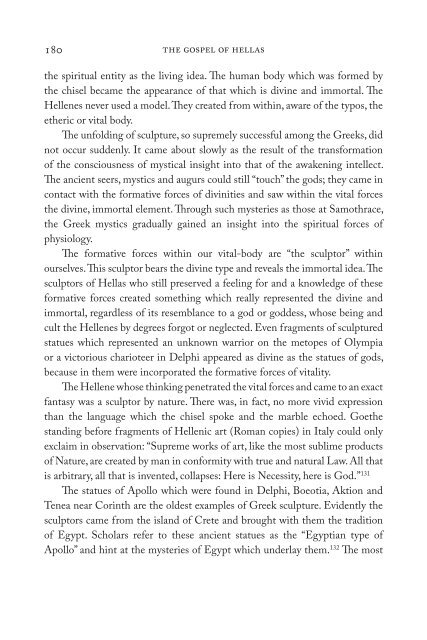The Gospel of Hellas - Research Institute for Waldorf Education
The Gospel of Hellas - Research Institute for Waldorf Education
The Gospel of Hellas - Research Institute for Waldorf Education
You also want an ePaper? Increase the reach of your titles
YUMPU automatically turns print PDFs into web optimized ePapers that Google loves.
0 the gospel <strong>of</strong> hellas<br />
the spiritual entity as the living idea. <strong>The</strong> human body which was <strong>for</strong>med by<br />
the chisel became the appearance <strong>of</strong> that which is divine and immortal. <strong>The</strong><br />
Hellenes never used a model. <strong>The</strong>y created from within, aware <strong>of</strong> the typos, the<br />
etheric or vital body.<br />
<strong>The</strong> unfolding <strong>of</strong> sculpture, so supremely successful among the Greeks, did<br />
not occur suddenly. It came about slowly as the result <strong>of</strong> the trans<strong>for</strong>mation<br />
<strong>of</strong> the consciousness <strong>of</strong> mystical insight into that <strong>of</strong> the awakening intellect.<br />
<strong>The</strong> ancient seers, mystics and augurs could still “touch” the gods; they came in<br />
contact with the <strong>for</strong>mative <strong>for</strong>ces <strong>of</strong> divinities and saw within the vital <strong>for</strong>ces<br />
the divine, immortal element. Through such mysteries as those at Samothrace,<br />
the Greek mystics gradually gained an insight into the spiritual <strong>for</strong>ces <strong>of</strong><br />
physiology.<br />
<strong>The</strong> <strong>for</strong>mative <strong>for</strong>ces within our vital-body are “the sculptor” within<br />
ourselves. This sculptor bears the divine type and reveals the immortal idea. <strong>The</strong><br />
sculptors <strong>of</strong> <strong>Hellas</strong> who still preserved a feeling <strong>for</strong> and a knowledge <strong>of</strong> these<br />
<strong>for</strong>mative <strong>for</strong>ces created something which really represented the divine and<br />
immortal, regardless <strong>of</strong> its resemblance to a god or goddess, whose being and<br />
cult the Hellenes by degrees <strong>for</strong>got or neglected. Even fragments <strong>of</strong> sculptured<br />
statues which represented an unknown warrior on the metopes <strong>of</strong> Olympia<br />
or a victorious charioteer in Delphi appeared as divine as the statues <strong>of</strong> gods,<br />
because in them were incorporated the <strong>for</strong>mative <strong>for</strong>ces <strong>of</strong> vitality.<br />
<strong>The</strong> Hellene whose thinking penetrated the vital <strong>for</strong>ces and came to an exact<br />
fantasy was a sculptor by nature. <strong>The</strong>re was, in fact, no more vivid expression<br />
than the language which the chisel spoke and the marble echoed. Goethe<br />
standing be<strong>for</strong>e fragments <strong>of</strong> Hellenic art (Roman copies) in Italy could only<br />
exclaim in observation: “Supreme works <strong>of</strong> art, like the most sublime products<br />
<strong>of</strong> Nature, are created by man in con<strong>for</strong>mity with true and natural Law. All that<br />
is arbitrary, all that is invented, collapses: Here is Necessity, here is God.” 131<br />
<strong>The</strong> statues <strong>of</strong> Apollo which were found in Delphi, Boeotia, Aktion and<br />
Tenea near Corinth are the oldest examples <strong>of</strong> Greek sculpture. Evidently the<br />
sculptors came from the island <strong>of</strong> Crete and brought with them the tradition<br />
<strong>of</strong> Egypt. Scholars refer to these ancient statues as the “Egyptian type <strong>of</strong><br />
Apollo” and hint at the mysteries <strong>of</strong> Egypt which underlay them. 132 <strong>The</strong> most

















